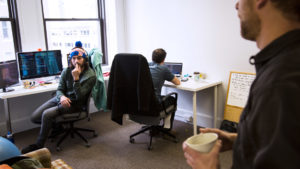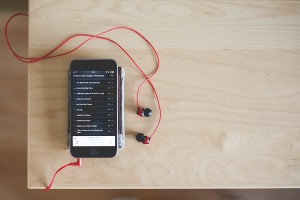No morning commute. No open floor plan that makes it challenging to focus on your work. No boss looking over your shoulder or co-worker who insists on showing you photos of his cat every morning. The sweet freedom of working from home can seem like a dream come true for some—and the number of people doing so is growing.

For example, Global Workplace Analytics found that the work-at-home population increased by 103% between 2005 and 2014, with a 6.5% rise in 2014—the largest spike since before the recession. U.S. Census data also show that working from home is more popular than ever. In 2010, 13.4 million people worked at least one day at home per week, an increase of more than 4 million people in the last decade.
Although statistics indicate that the trend is picking up steam, that doesn’t mean it’s easy to work from home successfully. Whether you’re telecommuting to a full-time job or running a home-based business, there are distinct challenges that come from merging your work and home lives.
To help you tackle the specific work issues you’re likely to face, we tapped three work-from-home experts for their tips on how to maximize four key areas of home-based office life so you can boost productivity and success.
Work-From-Home Tip #1: Turbocharge Your Space
Whether you’re working at the corner table next to the couch or have an entire spare room to devote to your home business, it’s important to create a space that helps get you into work mode and keeps your attention there.
• A little separation is a good thing: If you can, carve out a designated space in your home as an office where you can keep your work organized. “A separate workspace makes it easier to set boundaries between your home and office [fusion_builder_container hundred_percent=”yes” overflow=”visible”][fusion_builder_row][fusion_builder_column type=”1_1″ background_position=”left top” background_color=”” border_size=”” border_color=”” border_style=”solid” spacing=”yes” background_image=”” background_repeat=”no-repeat” padding=”” margin_top=”0px” margin_bottom=”0px” class=”” id=”” animation_type=”” animation_speed=”0.3″ animation_direction=”left” hide_on_mobile=”no” center_content=”no” min_height=”none”][lives],” says Lisa Kanarek, author of “Organize Your Home Office for Success: Expert Strategies That Can Work for You” and founder of WorkingNaked.com, a site that helps people create productive home offices. “When you have a separate space, you can store files, supplies and other business essentials in one area.”
If, however, your home office needs to be wherever you can find a spot to open your laptop, there are other things you can do. Elaine Quinn, a certified professional organizer, consultant for solo business owners and author of “There’s No Place Like Working from Home: Get Organized, Stay Motivated, Get Things Done!,” recommends using your dining table as a desk, especially if you have stacks of paperwork to sift through. If you’re working while your family is around, put on noise-canceling headphones to not only block out distracting sounds but serve as a visual cue to others that you’re on the clock.
• Get your (organizational) act together: Having an orderly desk helps you stay focused, boosting productivity so you don’t lose precious time looking for that critical contract—or whatever it may be—under a messy pile of papers. “Visual distraction is just begging for you not to be able to concentrate,” says Quinn. To minimize clutter, think of your desk as the center of a bull’s-eye. “All of the things you need on an everyday basis should be within arm’s reach,” she says. If you don’t need an item that often, it shouldn’t be on your desk. The next circle out should be items you don’t need more than once a week and can be stored off your desk, like in a nearby filing cabinet. The final, outer ring are items you need or want to hang onto but aren’t using anytime soon, such as old client files and contracts. These should be stored away in a closet or basement, if you have one.
If your office is the kitchen table one day and the back porch another, consider putting your work projects in separate boxes so you can grab the one you need at that time, and then put it away when you’re done.
• And remember, there may be tax benefits to creating a home office:Whether you rent or own your home, if you use part of the square footage regularly and exclusively for business, you may be able to do a home office deduction on your taxes, according to the IRS. The federal government now offers a fairly new (as of the 2014 tax season) simplified way to calculate this, with a standard deduction of $5 per square foot of the home used for business, with a maximum of 300 square feet. Talk with your accountant about the best way to include your home office expenses in your taxes.
RELATED: 6 Killer Morning Moves That Can Really Turbocharge Your Workday
Like this Article ? Share It ! You now can easily enjoy/follow/share Today our Award Winning Articles/Blogs with Now Over 2.5 Million Growing Participates Worldwide in our various Social Media formats below:
FSC LinkedIn Network: (Over 15K+ Members & Growing !) www.linkedin.com/in/frankfsc/en
Facebook: (over 12K) http://www.facebook.com/pages/First-Sun-Consulting-LLC-Outplacement-Services/213542315355343?sk=wall
educate/collaborate/network….Look forward to your Participation !
Continue of article:
Work-From-Home Tip #2: Stay Connected
When it comes to professional communication, Kanarek says that keeping your work and private lives separate is key. If you telecommute, it may be easier to set these boundaries with a work email that’s tied to your main office. If you have a home-based business, it can be trickier.
• Customize your communication: Instead of handing out your primary personal email for work-related matters, Quinn strongly urges her clients who are small business owners to create a second custom work email address, such as jane@yourcompany.com, for a more professional touch.
“Also, set up a third account that you give out when signing up for newsletters and updates,” Kanarek says. That way, you can stay in the loop without clogging up your business email account.
To better manage your inbox, there are tools that let you schedule emails so they’re sent during business hours, rather than when you’re burning the midnight oil. “If I don’t want to appear too eager to respond to something but don’t want to forget, I use Boomerang for Gmail,” says Quinn. “Or if I have an email that I don’t have to take action on right now, Boomerang can make that email reappear at the top of my list at a future date.”
You can also use apps to schedule texts to go out when you want, rather than pinging someone when you’re working on the weekend. Quinn uses SMS Scheduler, a delayed-text scheduler app on Android.
• Streamline your phone system: Many small business owners have ditched their landlines and exclusively use a mobile phone for business, says Kanarek. But if you use your primary number for work, it can be hard to gauge whether that incoming call is personal or business when you’re on—or off—the clock. To counter that, “some have one cellphone for business and the other for personal use,” Kanarek says. But Julie Morgenstern, time management expert and author of “Time Management From the Inside Out: The Foolproof System for Taking Control of Your Schedule—and Your Life,” prefers a dedicated business landline. “The sound quality can be better than on cellphones,” she says. Or you can use the phone line that often comes bundled with your cable TV subscription service as your business number.
If you’re using your own home phone or cellphone for business and don’t necessarily want your personal number out there, try using Google Voice, which lets you choose a brand new number from Google. “You can keep cycling through to find a number you like,” says Quinn. “Or you can type in words and see if they have the numbers to correlate.” If you’re more concerned with missing a call, you can use your existing mobile number with Google Voice and set it up so that one number rings to all of your phones. The service also provides online voicemail with rough transcriptions, sent to you by email or text, so you can quickly get the gist of voicemails on the go.
RELATED: 5 Productivity Apps That’ll Kick Your Workday Into High Gear
Work-From-Home Tip #3: Create a Schedule That Fits Your Life
If you’re telecommuting, your hours may be set by your boss. But if your office is flexible or you run a business out of your home, one of the perks is setting your own hours. While there’s freedom in that flexibility, it’s also easy for work-life balance to get really out of whack. Make sure you create a regular schedule, says Morgenstern. “It’s a hot mess when people work whenever they feel like. People love structure. It’s a forcing mechanism that energizes you and also helps you shut off when it’s time.”
• Block out your days with a hard stop: Morgenstern recommends thinking of your day in three blocks of time—morning, afternoon and evening—and factor in how much energy you have in each time period. “If you’re more productive in the morning, then get up and do your work then,” she says. You should also factor in what time you typically need to interact with co-workers and clients, as well as your family’s schedule.
“You may want to be done for the day when your kids come home from school, for example,” Morgenstern says. That way, your kids’ arrival signals quitting time instead of being a distraction keeping you from working another few hours.
• Be realistic about your time: Anyone can write a to-do list, but completing every action is another feat entirely, especially if you’re overly optimistic about what you can reasonably accomplish in a day. Instead of creating a never-ending task list, Morgenstern advises asking yourself three questions: What do I need to do? How long will that take? When will I do it? Keeping in mind your deadlines for each, prioritize and block out your schedule to tackle these responsibilities during a time window when you can maximize your attention toward them.
Not sure how to prioritize tasks? “Think of your work week as a time budget,” Morgenstern says. For example, “if you’re doing writing, editing, administration and pitching, those are the four categories of your time budget. Then, create a regular routine of when you do each. A little bit of boundaries [between task categories] helps.”
• Don’t forget to schedule breaks: In general, whatever schedule you choose, aim to work no more than 90 minutes at a time before taking a quick break. The combination will keep you productive and give you time to clear your head. “After that time, most people lose focus anyway,” Quinn says. “You’ll work better in 90-minute chunks.” Others, including Quinn, find that working in even smaller chunks—up to 45 minutes, followed by a 15-minute break—is more efficient.
Work-From-Home Tip #4: Know That You Don’t Have to DoEverything
It can be overwhelming when you are your own tech support, accountant and executive assistant while working from home. And the truth is, “anyone who is working from home can’t do everything themselves,” Quinn says. So how do you make sure you keep your business running?
• Get your go-to people in place: Luckily, this is easier than ever since there are plenty of businesses geared toward home-based workers that offer tech support, such as Support.com, and billing services, such as FreshBooks, at reasonable prices. “It’s always a good idea to get referrals from others,” Kanarek says. “I use Quicken and I have a Mac tech person who always knows how to solve any tech issues I may have.” Some tech support consultants can even virtually jump into your computer and see if they can fix something easily.
• Go virtual: Quinn recommends using a virtual assistant from theInternational Virtual Assistants Association (IVAA), which connects you with professional independent contractors who can offer administrative, technical and creative support. A virtual assistant can help with various tasks, such as bookkeeping and following up on outstanding invoices, creating a monthly newsletter or doing research for a work project. But if you have simple, straightforward tasks like booking appointments, transcribing notes or faxing documents, Quinn suggests finding a more affordable virtual assistant through services like Upwork or Fiverr. Whichever route you choose, having a virtual assistant saves you from getting bogged down in mundane tasks, allowing you to spend more time focusing on building your home-based business and reaping the rewards.
Forbes.com | February 2, 2016 | LearnVest
[/fusion_builder_column][/fusion_builder_row][/fusion_builder_container]







